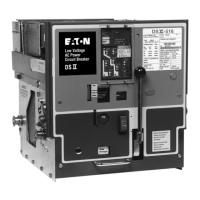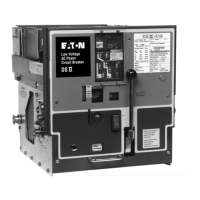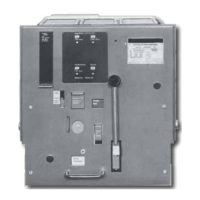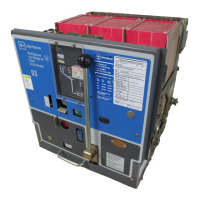the circuit breaker. Wipe accessible areas with a clean and
dry lint-free cloth. Carefully inspect the contacts.
NOTICE
SWITCHING, FAULT INTERRUPTIONS AND THE MAKING OF
MOTOR INRUSH CURRENTS WILL CAUSE SOME PITTING OF
THE BREAKER CONTACT PARTS. A LARGE ACCUMULATION OF
OPERATIONS WILL GIVE THE CONTACTS, ESPECIALLY THE ARC-
ING CONTACTS, A MOTTLED, DIRTY, ERODED APPEARANCE. THIS
APPEARANCE IS THE NORMAL RESULT OF ARC BURNING AND IN
ITSELF IS NO CAUSE FOR CONCERN.
During any inspection, cleaning, part adjustment or part
replacement, be certain to look over all visible parts for miss-
ing pin retainers, loose hardware, bent, worn or damaged
parts. Be especially alert for foreign matter that should be
removed. Make appropriate corrections to anything found
out of order.
After any such activity, make sure that all parts are properly
installed on the breaker, especially the arc chutes and all
four barriers. Take the time to double check all work against
provided drawings and written instructions.
5-4.1 DSII-308 Through DSII-620 Inspection
NOTICE
DSII-516 ADJUSTMENTS AND MAINTENANCE APPLY TO THE
DSII-508. DSII-620 ADJUSTMENTS AND MAINTENANCE APPLY TO
THE DSII-608 AND DSII-616.
Remove the barriers and arc chutes to expose the contacts.
With the breaker open, examine the contact tips of the mov-
ing and stationary arcing and main contacts (Figures 5-1 and
5-2). If the tips are burned or worn more than .030 inches,
the contacts must be replaced. Also check the dimension
(C) between the stationary arcing contacts. It should be .420
plus or minus .08 inches. If this dimension is not maintained,
the stationary arcing contacts must be replaced.
Close the breaker and check the contact engagement
(Figures 5-1 and 5-2). The main stationary contact fingers
should be parallel (B) to the fixed contact cage. If not, adjust
the contacts according to Paragraph 5-5.3. Also check the
dimension (A) between the stationary arcing contacts and
the center section of the cage. If this dimension is not .02
inches or greater, the stationary arcing contacts should be
replaced.
NOTICE
BE CERTAIN THAT ALL BARRIERS AND ARC CHUTES ARE RE-
PLACED AFTER THE INSPECTION IS COMPLETED.
5-4.2 DSII-632 and DSII-840/850 Inspection
In addition to the requirements for the DSII-308 through
DSII-620 outlined in Paragraph 5-4.1, several additional pro-
cedures are required (Figures 5-3 and 5-4).
The lower main fixed contacts should be inspected to
ensure that they have adequate contact pressure. This is de-
termined by Pin “X” being free to slide in the contact cage.
Unlike the DSII-308 through DSII-620 breakers, the top row
of fixed main contacts are compressed beyond the parallel
position to assure adequate contact pressure for the lower
row of fixed main contacts.
5-4.3 DSII-308 Contact Replacement
To replace the stationary contacts, remove the rear mounted
disconnect finger contacts (Figure 3-1), followed by the two
bolts holding the upper contact assembly to the molded
base. Withdraw the contact assembly from the front.
Replace the removed contact assembly with a new contact
assembly. Be certain that all bolts are tightened securely.
Close the breaker and check all contact dimensions as out-
lined in Paragraph 5-4.1.
Both the main moving and arcing contacts are held between
the two moving arms by two bolts with self-locking nuts.
Removal of the two bolts permits the replacement of the
moving contacts. These bolts must be securely tightened
after replacement.
The fixed arcing contacts are held by a single bolt passing
through the contacts and their pressure springs. On reas-
sembly, the self-locking nut is tightened so that a dimension
of 3.12 inches is obtained between the inside surfaces of
the flat washers on the spring ends.
5-4.4 DSII-516 Through DSII-840/850 Contact Replace-
ment
The moving arcing and main contacts are secured to the
moving contact assembly by two bolts. Removal of
Effective July 2010
Instructional Book IB694C694-03
52
EATON CORPORATION www.eaton.com

